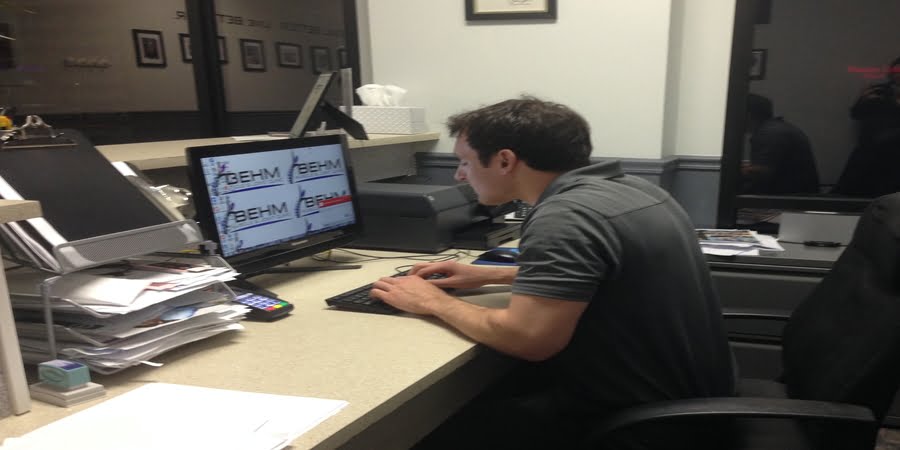Foam Rolling for Sitting At a Desk
The average office worker spends approximately 10 hours per day sitting. Ten. If you work at a desk and typically sit for extended periods of time during the day, you are familiar with that uncomfortable, hunched over look that most of the older employees have. You know the ones, complaining of back, shoulder, and knee joint pain.
Over time, sitting in the same position can negatively impact your posture and the way your body is intended to move. Our bodies are designed to be upright and moving, not static all day sitting in a swivel chair. Ergonomic improvements lessen postural burden but your body is still going to be stuck in certain positions for hours on end. Hours per day, times days per year, times years in your executive career and you are going to slowly but surely reset your natural posture to accommodate the posture you maintain at work.
- Sitting bending your legs shortens your calves robbing you of ankle ROM
- Sitting causes your glutes to turn off and your hip flexors to shorten
- Sitting rounds your back increasing your risk low back pain
- Pecs shorten rounding your shoulders forward
The muscles that are contracted all day while sitting at a desk develop knots in them. These knots (or adhesions) limit flexibility of the muscle which decreases the ROM of your joints. Putting pressure on those knots with a foam roller will help massage the knot out so the muscle can return to its intended length.
Foam rolling relieves the pain of sitting at a desk
Below are 3 essential areas to foam roll: the calves, back and hips. At Behm Muscle & Joint Clinic we utilize the joint by joint approach, the body is simply just a stack of joints. Each joint or series of joints has a specific function and alternate between mobility and stability. The ankle needs increased mobility, and the knee needs increased stability, hips need mobility, low back stability, and mid-back mobility.
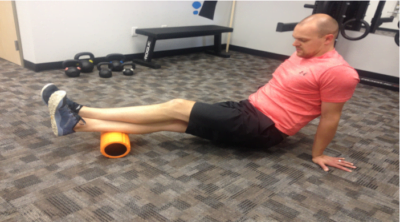
Foam rolling calves
Calves – To roll out your calves, place one calf over the foam roller near your heel. Cross the other foot on top of the leg on the foam roller or ball. Rock right to left or side-to-side a couple of times and then roll the foam roller up higher on your calf toward you knee. Keep rocking side to side as you work your way up your calf. Stay longer on tight spots. If you find a knot, make 10 circles with your foot and then tense and relax your calf (flexing and dropping your foot) 5 times before you move to the next spot. Repeat all the way up both calves.
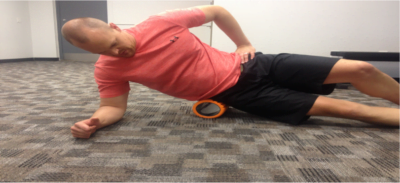
Foam rolling side of hip
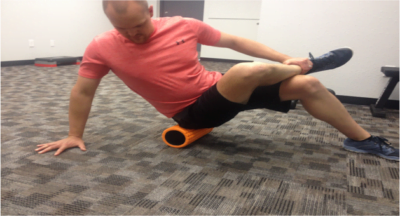
Foam rolling back of hip
Hips – Tight hips often mean we’ll suffer from low back pain and may even end up with knee problems. When our hips are locked up, our glutes aren’t active therefore other, smaller muscle groups must compensate to help us move. To roll out the back of your hip, sit on the roller and reach your right arm behind you, planting your right hand on the floor a few inches behind you. Cross your right ankle over your left knee in a figure four position. Slightly shift your weight to the right hip/glute area and roll back and forth a few inches in each direction for about 30 seconds. Repeat on the opposite side. To roll out the side of your hip, start by lying on your side, with a foam roller under the outside of one hip, leg extended, using your other leg and arms to support you. Roll along the small mound of muscle between your hip and pelvis. Repeat with the roller under your other hip. Work the foam roller back and forth, gliding your muscle over the foam roller, for 30 to 60 seconds on each hip.
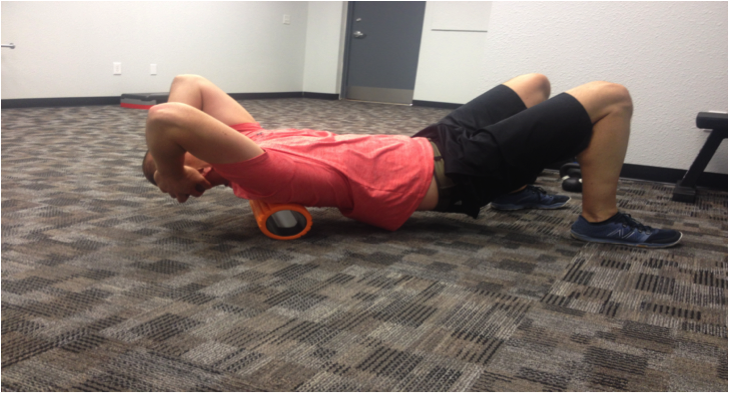
Foam rolling mid back
Thoracic Spine – Because we sit rounded forward all day, we restrict our ability to extend through our mid back. To improve your posture, you can use a roller to work on your extension. To roll out your back, start with the roller at the middle of your back. Extend back over the foam roller, keeping your butt on the ground while you try to touch your head to the ground behind the roller. Then move the roller up higher and extend again, keeping the butt on the ground. Work all the way up your mid back.
The Behm Muscle & Joint Clinic approach to postural desk pain
Behm Muscle & Joint Clinic is a movement-based Chiropractic, rehabilitative and soft tissue therapy clinic in Bellevue, NE. The above foam rolling techniques should be used as a guide for alleviating some of the muscular imbalances that prolonged sitting can have on the body. If you are dealing with chronic lower back, shoulder or hip pain do not hesitate to give us a call at 402-292-1450 or schedule a consultation online. Addressing joint restrictions and muscle imbalances as well as incorporating exercises to strengthen muscles turned off by sitting help to alleviate chronic pain and reduce the risk of injury for the weekend warrior.
About the author
Dr. Behm was born and raised in Papillion, NE. He received his Bachelor’s degree in Exercise Science from the University of Nebraska – Omaha and following his undergraduate studies was a certified personal trainer (NSCA-CPT – National Strength and Conditioning Association) in the Omaha area for years, helping clients achieve their health and fitness goals. He received his Doctorate in Chiropractic from Cleveland Chiropractic College – Kansas City. While in school, he received multiple certifications to increase his knowledge of the human body and how to properly assess and treat his patients. This translates into our integrative approach to Chiropractic care and our combination of therapies to better address your musculoskeletal complaints. Dr. Behm is excited to return to his hometown and serve the community around him.
